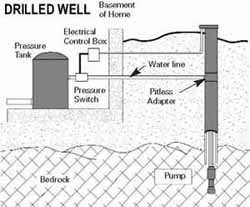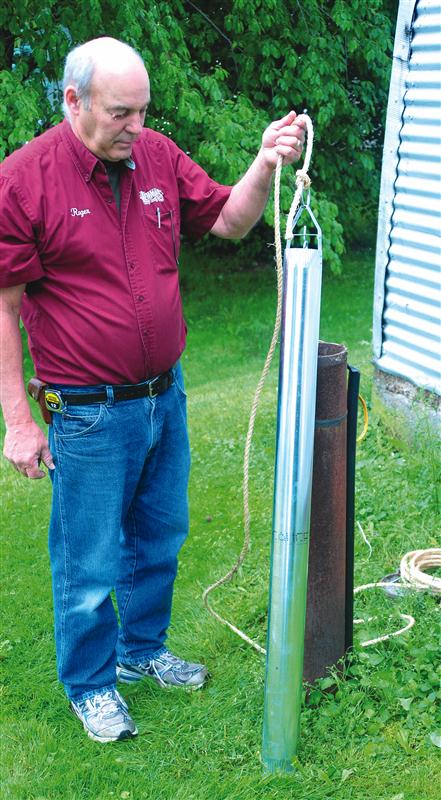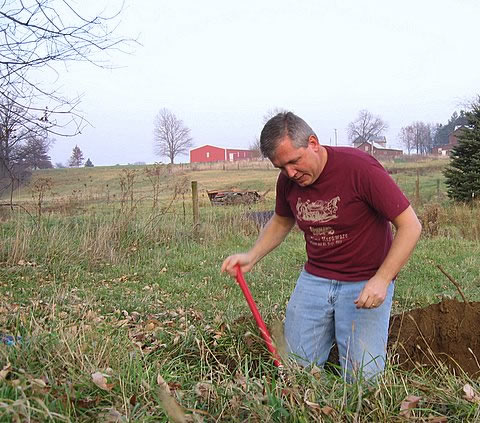If you live in the country, you probably get your water from a drilled well in your basement or backyard. In most cases, the “well” looks like a steel or plastic pipe about 4″ to 5″ diameter that projects a few inches above ground and has a steel cap on it.
Depending on the depth of the well, there’s either an above-ground pump (often called a jet pump) or “deep well” submersible electric pump hidden in the well.

Either way, a power failure can leave you high and dry. Because well pump systems incorporate a storage tank (sometimes called a pressure tank), you may have a access to 20-30 gallons even without electricity. But, it’s astonishing how fast it runs out. And, how much you miss access to fresh water after it’s gone!
It’s doubly frustrating, because in many cases you can actually see the water in the bottom of the well. It’s just too far away to reach! Fortunately, we have two ways to solve the problem.
Low-Cost Well Bucket

It’s just 3 1/2 inches in diameter. That narrow profile means it will fit into many drilled wells. (Make sure you confirm that it will work in your installation before a power failure hits!)
It’s a pretty ingenious design, if I do say so myself. There’s a valve in the bottom that automatically opens as soon as the bucket hits the water, allowing it to fill from the bottom up. It holds nearly two gallons, and the rubber gasketed valve automatically closes and seals to hold the water in as soon as you start drawing the bucket back up.
Convenient, durable hand pump
We also have a tough, light pump made from stainless steel and thermoplastic. Because it pumps up to 10 gallons per minute, it’s your most convenient option. It comes in two versions, one for shallow wells and one for deep wells.
What makes it such a perfect solution for emergency use? It’s light and easy to install. It works in many drilled wells (if the casing is more than 6″ diameter). It’s tough, durable and reliable.
The shallow well version works if the water is within about 20 feet. All you need to do is add enough 2″ diameter PVC pipe (available from any hardware or plumbing supply store) to reach the water. You can tell how far it is to the water by dropping a weighted string down into the well.
Like any shallow well pump, it may need priming the first time you use it. “Priming” means pouring water into the pump to make it wet. If you’ve used all the water in your pressure tank, you may be able to use melted ice or water from the tank on the back of your toilet. (It doesn’t take very much.)
The deep well pump uses a “cylinder” that does all the work. The “pump” (sometimes called a pump head) is nothing more than a hollow housing. Because the cylinder is installed under water it stays wet all the time. Therefore, deep well pumps never need primed. For this reason, people often use a deep well pump even on shallow wells.
The two components are connected by equal lengths of 2″ PVC pipe and 1/2″ PVC pipe. The 2″ pipe, often called a “drop pipe,” is the conduit through which the water travels. The 1/2″ pipe acts as the rod that transmits the pumping action from the pump to the cylinder.
At Lehman’s, our goal is to provide you with more than just the supplies you need to live without electricity. We also want to provide you with the knowledge you need to choose the right items and use them correctly. That’s why we train, test and certify our staff to answer your water pumping questions.
Need help to solve a non-electric pump problem? Give us a call at 800-438-5346! You can see our full line of pump products by clicking here. We’ll do our best to help you!
NOTE: The home’s well is your source of drinking water. Make sure that everything you put in the well is clean and sterile. Do not allow contaminants to enter while the well cap is off. Don’t leave the well cap off for long periods of time.
PS – My goal with this article was to provide complete and clear information on emergency non-electric water pumping. Did I miss anything? Please let me know if I can make the article better.
Editor’s Note: This post was first published in 2010. It’s gotten so many views we decided to offer the information again!


































Thank you for this. Our world is scary right now. Our own government is against us. Prepping for every possible time that could happen is expensive and overwhelming. Water has been a big concern for me. The well bucket is something anyone can do. ?
Yes if you have a well on your property; please see this information from our web site:
Get water from any well by hand! Our well buckets work at any depth. Special leak-proof valve opens to fill then closes automatically when bucket is drawn up. Use for emergencies and temporary installations. Not intended for everyday use.
Glenda Lehman Ervin
Hi, I have the concern that if the electricity goes down, we will be without water! We have a jet pump, so what options would you have for those kinds or would this bucket work for this type as well? Thank you kindly.
would this work with a submersible pump
Note: 1 gallon of water weighs 8.33 pounds or 3.78 kilograms at room temperature.
How much does this weigh? Is it made of teflon with a ball on the opposite end to keep the water inside?
I have a 36 inch X5O ft well. the cap or lid is very hard to move it is concrete. How do I get water from well if electric goes down ? Is there any way to set up a manual way to procure water?duck duck go
My well is 47 ft deep can I extract water with this product without pulling my submersible pump out
When do you plan on getting the buckets back in stock? Looking forward to having one as a backup